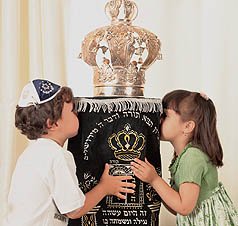|
We received the Torah twice. The first time, Moses ascended Mount Sinai on the holiday of Shavuot, and remained there for 40 days, preparing to receive the Tablets, the luchot. Unfortunately, however, they did not last for long. When Moses descended the mountain at the end of 40 days, he saw the Jewish people worshipping a golden calf. Immediately, he threw down the tablets and shattered them.
Moses fasted and prayed on behalf of the Jews for another 40 days, until Rosh Chodesh Elul, when G-d agreed to forgive them. Moses ascended the mountain once again, and on Yom Kippur, he prevailed upon G-d to forgive the Jews completely. That is when Moses came down from Mount Sinai with a second set of luchot.
This is the reason why we celebrate Simchat Torah in the month of Tishrei, not on Shavuot or close to it. We express our joy primarily for the second set of luchot that we received--after returning to G-d with complete teshuvah after the sin of the golden calf. Yom Kippur itself, the day that the luchot were actually received, we dedicate to prayer and repentance. However, Yom Kippur is immediately followed by Sukkot, a holiday noted for its exceptional joy, culminating with our rejoicing with the Torah on Simchat Torah.
*
The fact that Simchat Torah is celebrated in conjunction with Yom Kippur emphasizes one of the fundamental principles of Chassidism. Before the Baal Shem Tov appeared on the scene and revealed the teachings of Chassidism, there was a profound division within the Jewish community. The learned scholars held the simple working folk beneath their contempt, due to their ignorance in Torah. The simple folk, for their part, felt cast out of the mainstream of Jewish life. The hard life of toil that they led left them with little time or resources to study Torah; yet, for this, they were cruelly mocked.
When the Baal Shem Tov came along, he bridged the gap between the scholars and the simple folk. He drew the people close and shared with them the wisdom of the Torah, using parables and stories that they could easily grasp. He instilled within them how deeply cherished they were by G-d. He taught the scholars to hold dear all Jews, due to the soul, the neshamah, that G-d had implanted within them. On a soul level, there is no difference between the greatest scholar and the simplest ignoramus. Every Jew is intrinsically bound with G-d and the Torah--and in this bond, all are equal.
This theme is emphasized on Simchat Torah. The first time that the Torah was given, on Shavuot, all Jews were on the level of complete tzadikim, without blemish. However, the theme of Tishrei is teshuvah, return. We received the Torah for a second time, after undergoing a process of repentance for the sin of the golden calf. This time around, the Torah does not belong only to the perfect folk. It belongs to all of us, including those who still have a long way to go towards reaching perfection. Our personal perfection is not important on Simchat Torah; what is important is our intrinsic, essential bond with G-d and the Torah.
On Simchat Torah, we rejoice and dance with the Torah as it is wrapped in its mantle. Through this, we demonstrate that our joy is not connected to how much Torah we have studied or how deeply we have comprehended it. Just the very fact that we are Jews who possess this treasure, the Torah, is enough to elicit our unbounded joy.
|

